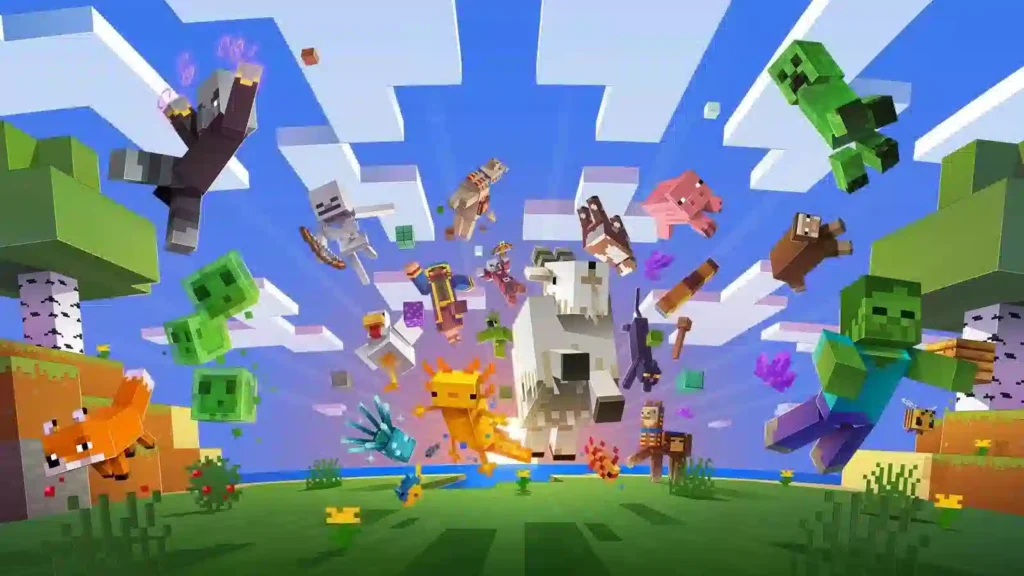Minecraft is a game that encourages creativity and exploration, but for those looking to optimize their resources, building efficient farms is key. Whether you’re a new player or a seasoned veteran, understanding how to set up different types of farms can significantly enhance your gameplay. This guide will walk you through the process of building various farms in Minecraft, covering everything from basic crop farms to complex mob farms.

1. Understanding the Basics of Farming in Minecraft
Before diving into specific farm types, it’s important to understand the basics of farming in Minecraft.
What is Farming in Minecraft?
Farming in Minecraft refers to the process of cultivating crops, breeding animals, and gathering resources in an organized and sustainable way.
- Crops: Wheat, carrots, potatoes, and beetroots are the primary crops you can grow.
- Animals: Cows, pigs, sheep, and chickens are common farm animals.
- Resources: Mob farms can provide valuable resources like bones, gunpowder, and string.
Why Farming is Important
Farming is essential in Minecraft for several reasons:
- Sustainability: Farms provide a consistent supply of food and resources, reducing the need to search for them.
- Efficiency: Automated farms can save time and effort, allowing you to focus on other aspects of the game.
- Survival: In survival mode, having a steady food supply is crucial to avoid starvation.
Basic Tools and Materials
To get started with farming, you’ll need some basic tools and materials:
- Hoe: Used to till soil for planting crops.
- Water Buckets: Essential for irrigating crop fields.
- Fencing: Keeps animals contained within your farm area.
- Seeds and Saplings: Needed to grow crops and trees.
2. Building a Simple Crop Farm
A simple crop farm is the foundation of any Minecraft farming setup. Let’s start with a basic wheat farm.
Preparing the Land
The first step in building a crop farm is preparing the land.
- Tilling the Soil: Use a hoe to till the soil where you want to plant your crops. Each tilled block can hold one seed.
- Irrigation: Water is necessary for crops to grow. Place water sources within four blocks of your crops to keep the soil hydrated.
- Lighting: Crops need light to grow. Place torches or glowstone around your farm to ensure crops grow even at night.
Planting and Harvesting Crops
Once the land is prepared, you can start planting your crops.
- Planting: Place seeds on tilled soil. Common crops include wheat, carrots, potatoes, and beetroots.
- Growing Time: Crops take time to grow. You can speed up the process with bone meal.
- Harvesting: Once the crops are fully grown, you can harvest them by breaking the plant. Replant the seeds immediately for continuous production.
Expanding Your Farm
As you gather more resources, consider expanding your crop farm.
- Multiple Layers: Create multiple layers of farmland to maximize space.
- Automated Watering: Use dispensers and redstone to automate the watering process, saving time and effort.
3. Creating an Animal Farm
Animal farms provide essential resources like meat, wool, and leather. Here’s how to create an efficient animal farm.
Choosing the Right Location
The location of your animal farm can affect its efficiency.
- Flat Terrain: Choose a flat area to make fencing and feeding easier.
- Proximity to Home: Build your farm close to your base for easy access.
Building Pens and Fences
Contain your animals with pens and fences to keep them organized and prevent them from wandering off.
- Fencing: Use wooden fences to create a secure area for your animals.
- Gates: Place gates in your fences for easy access to your animals.
- Pens: Divide your farm into separate pens for different animal types (e.g., cows in one pen, sheep in another).
Breeding and Feeding Animals
Breeding animals is the key to expanding your farm and gathering resources.
- Feeding: Use specific items to feed and breed animals (e.g., wheat for cows and sheep, carrots for pigs).
- Breeding: Feed two animals of the same type to make them breed and produce offspring.
- Resource Collection: Harvest resources from your animals, such as milk from cows, wool from sheep, and eggs from chickens.
4. Building an Automated Crop Farm
Automating your crop farm can save you time and effort. Here’s how to build a basic automated farm.
Understanding Redstone Basics
Redstone is the key to automation in Minecraft. Understanding the basics will help you create automated systems.
- Redstone Dust: Used to transmit power to devices like pistons and dispensers.
- Pistons: Push blocks or crops when powered by redstone.
- Dispensers: Release items like water or bone meal when activated by redstone.
Setting Up the Farm
To create an automated crop farm, you’ll need to combine redstone with pistons and dispensers.
- Water Flow: Use dispensers filled with water buckets to create a flow of water that harvests your crops.
- Redstone Circuit: Connect the dispensers to a redstone circuit that you can activate with a lever or button.
- Crop Replanting: After harvesting, manually replant the crops, or use villagers to automate this process.
Harvesting and Collection
Once your farm is set up, you can easily harvest crops by activating the redstone circuit.
- Harvesting: Activate the circuit to release water and harvest your crops.
- Collection: Use hoppers and chests to collect the harvested crops automatically.
5. Building a Villager-Based Crop Farm
Villagers can be used to automate the planting and harvesting of crops. Here’s how to create a villager-based farm.
Acquiring Villagers
You’ll need at least one villager to get started with this type of farm.
- Villager Breeding: Create a small village with beds and food to encourage villagers to breed.
- Transporting Villagers: Use minecarts or boats to move villagers to your farm location.
Designing the Farm
The design of a villager-based farm is crucial for its efficiency.
- Farm Layout: Create a 9×9 plot of farmland with water in the center.
- Villager Positioning: Place a composter near the center to turn one villager into a farmer. The farmer will automatically plant and harvest crops.
- Fencing: Surround the farm with fences to keep the villager contained and safe from mobs.
Automating Crop Collection
To automate the collection process, use hoppers and minecarts.
- Minecart with Hopper: Place a minecart with a hopper underneath the farmland to collect harvested crops.
- Collection System: Use rails to guide the minecart to a collection point where it can unload the crops into a chest.
6. Creating a Mob Farm
Mob farms are essential for gathering resources like bones, gunpowder, and string. Here’s how to build a basic mob farm.
Choosing the Right Location
Location is key when building a mob farm.
- High Up or Underground: Build your mob farm high in the sky or deep underground to maximize spawn rates.
- Away from Base: Keep your mob farm away from your base to avoid unwanted mob spawns.
Building the Spawning Platform
The spawning platform is where mobs will spawn before being funneled into a collection system.
- Platform Design: Create a large, dark platform where mobs can spawn. Use trapdoors to force mobs into a water stream.
- Water Flow: Use water to push mobs into a central collection point.
- Height: Drop the mobs from a height that leaves them with one heart of health, making them easy to kill.
Killing and Collecting Drops
Once the mobs are funneled to the collection point, it’s time to gather their drops.
- Killing Mechanism: Use fall damage or a trident killer to kill the mobs.
- Collection System: Use hoppers to collect the drops and funnel them into chests for easy access.
7. Building a Bamboo and Cactus Farm
Bamboo and cactus farms are useful for producing fuel and green dye. Here’s how to create an efficient bamboo and cactus farm.
Setting Up the Farm
Bamboo and cactus farms can be combined for efficiency.
- Farm Layout: Create a grid pattern for planting bamboo and cactus.
- Water Channels: Use water channels to collect the bamboo and cactus as they grow and break.
- Collection System: Use hoppers to collect the items and store them in chests.
Automating the Farm
Automation can make your bamboo and cactus farm even more efficient.
- Pistons and Observers: Use pistons and observers to automatically break bamboo and cactus when they reach a certain height.
- Redstone Circuit: Connect the pistons and observers to a redstone circuit for automated harvesting.
Using the Farm
Once the farm is set up, you’ll have a steady supply of bamboo and cactus for fuel and dye.
- Fuel: Use bamboo as fuel for smelting and cooking.
- Dye: Craft green dye from cactus for various crafting recipes.
8. Building a Tree Farm
Wood is a crucial resource in Minecraft, and a tree farm can ensure you never run out. Here’s how to build an efficient tree farm.
Choosing the Right Tree Type
Different trees require different farming methods.
- Oak Trees: Easy to farm and don’t require much space.
- Spruce Trees: Ideal for large-scale wood production.
- Jungle Trees: Produce a large amount of wood but require more space.
Setting Up the Farm
Once you’ve chosen the tree type, it’s time to set up the farm.
- Planting: Space your saplings according to the tree type’s growth requirements.
- Bone Meal: Use bone meal to speed up the growth process.
- Lighting: Ensure your farm is well-lit to prevent mobs from spawning.
Harvesting Wood
Once your trees are fully grown, it’s time to harvest the wood.
- Manual Harvesting: Chop down the trees with an axe.
- Automated Harvesting: Use pistons to automatically harvest the trees (requires more advanced redstone knowledge).
9. Building a Sugarcane Farm
Sugarcane is a versatile crop used for crafting paper and sugar. Here’s how to create a sugarcane farm.
Choosing the Farm Location
Sugarcane must be planted next to water, so location is important.
- Water Source: Ensure your farm is near a body of water or use water buckets to create a water source.
- Flat Terrain: Choose a flat area to make planting and harvesting easier.
Setting Up the Farm
Once you’ve chosen a location, set up your sugarcane farm.
- Planting: Plant sugarcane on dirt or sand blocks adjacent to water.
- Water Flow: Use water channels to collect the sugarcane as it grows.
- Lighting: Ensure your farm is well-lit to prevent mobs from spawning.
Automating the Farm
Automation can save time and effort when farming sugarcane.
- Pistons and Observers: Use pistons and observers to automatically break sugarcane when it reaches a certain height.
- Redstone Circuit: Connect the pistons and observers to a redstone circuit for automated harvesting.
10. Building a Honey Farm
Honey is a valuable resource in Minecraft, used for crafting and food. Here’s how to create a honey farm.
Acquiring Bees
Bees are essential for honey production. You’ll need to find a beehive or bee nest.
- Beehives: Found in flower forests, plains, and sunflower plains biomes.
- Luring Bees: Use flowers to lure bees to your farm location.
- Breeding Bees: Breed bees with flowers to increase the number of bees in your farm.
Setting Up the Farm
Once you have bees, you can set up your honey farm.
- Beehives or Bee Nests: Place beehives or bee nests near your flowers to encourage honey production.
- Flowers: Plant flowers around the beehives to keep the bees happy and productive.
- Harvesting Honey: Use glass bottles to collect honey or shears to collect honeycombs.
Automating the Farm
Automation can make your honey farm more efficient.
- Dispensers: Use dispensers with glass bottles or shears to automatically collect honey and honeycombs.
- Redstone Circuit: Connect the dispensers to a redstone circuit for automated harvesting.
Conclusion
Building efficient farms in Minecraft can greatly enhance your gameplay experience. Whether you’re growing crops, raising animals, or gathering resources from mobs, the key to success lies in careful planning and automation. By following the steps outlined in this guide, you’ll be well on your way to creating a self-sustaining Minecraft world. Happy farming!




